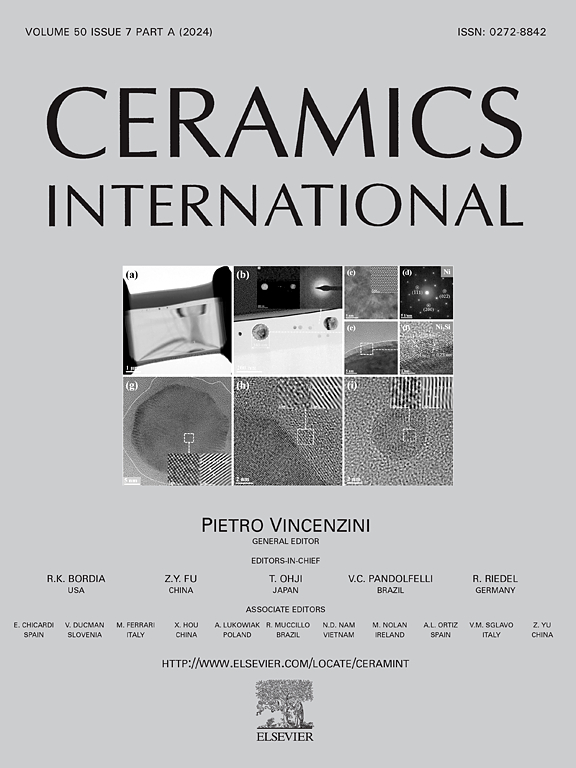Hollow MgF2@TiO2 self-cleaning nanocoatings for photovoltaic performance enhancement
IF 5.6
2区 材料科学
Q1 MATERIALS SCIENCE, CERAMICS
引用次数: 0
Abstract
The efficiency of photovoltaic (PV) modules, the core unit for converting solar energy to electricity, is limited by the reflection loss of the glass cover and the adsorption of organic pollutants. Thus, the development of coatings with antireflective and self-cleaning composite functions is important. In this study, based on the sol-gel method, hollow MgF2/TiO2 (MgF2@TiO2) composites were prepared and, combined with the Essential Macleod software, coatings were designed and optimized. Using this approach, a three-layer antireflective coating with a self-cleaning function was developed. Moreover, subjecting the MgF2@TiO2 composites to 24 h heat treatment resulted in the production of MgF2 with a stable hollow rod structure and a refractive index of 1.18. The photocatalytic performance of TiO2 was enhanced by optimizing the annealing temperature, and the strongest effect was achieved at 300 °C. In addition, the optimization of the coating structure resulted in a gradient refractive index coating with high process tolerance, with an average reflectance of 0.81 % in the visible wavelength band. The application of the coating to mini-PV modules increased the light transmittance to 97.58 % and the efficiency of the module by 5.71 %, with a strong self-cleaning effect. The coating was demonstrated to have excellent durability and reliability upon exposing it to 2000 h of damp heat and subjecting it 1000 abrasion cycles. This study promotes the design and application of functional coatings on the surfaces of PV modules.
提高光伏性能的中空MgF2@TiO2自清洁纳米涂层
光伏(PV)组件是将太阳能转化为电能的核心单元,其效率受到玻璃罩反射损失和有机污染物吸附的限制。因此,开发具有抗反射和自清洁复合功能的涂层是非常重要的。本研究基于溶胶-凝胶法制备了中空MgF2/TiO2 (MgF2@TiO2)复合材料,并结合Essential Macleod软件对涂层进行了设计和优化。利用这种方法,研制了一种具有自清洁功能的三层抗反射涂层。此外,将MgF2@TiO2复合材料热处理24 h,得到的MgF2具有稳定的空心棒结构,折射率为1.18。通过优化退火温度,TiO2的光催化性能得到增强,在300℃时效果最强。此外,通过对涂层结构的优化,得到了具有高工艺容忍度的梯度折射率涂层,在可见光波段的平均反射率为0.81%。该涂层应用于微型光伏组件后,透光率提高到97.58%,组件效率提高了5.71%,具有较强的自清洁效果。该涂层暴露在2000小时的湿热和1000次磨损循环下,证明了其优异的耐久性和可靠性。本研究促进了光伏组件表面功能涂层的设计与应用。
本文章由计算机程序翻译,如有差异,请以英文原文为准。
求助全文
约1分钟内获得全文
求助全文
来源期刊

Ceramics International
工程技术-材料科学:硅酸盐
CiteScore
9.40
自引率
15.40%
发文量
4558
审稿时长
25 days
期刊介绍:
Ceramics International covers the science of advanced ceramic materials. The journal encourages contributions that demonstrate how an understanding of the basic chemical and physical phenomena may direct materials design and stimulate ideas for new or improved processing techniques, in order to obtain materials with desired structural features and properties.
Ceramics International covers oxide and non-oxide ceramics, functional glasses, glass ceramics, amorphous inorganic non-metallic materials (and their combinations with metal and organic materials), in the form of particulates, dense or porous bodies, thin/thick films and laminated, graded and composite structures. Process related topics such as ceramic-ceramic joints or joining ceramics with dissimilar materials, as well as surface finishing and conditioning are also covered. Besides traditional processing techniques, manufacturing routes of interest include innovative procedures benefiting from externally applied stresses, electromagnetic fields and energetic beams, as well as top-down and self-assembly nanotechnology approaches. In addition, the journal welcomes submissions on bio-inspired and bio-enabled materials designs, experimentally validated multi scale modelling and simulation for materials design, and the use of the most advanced chemical and physical characterization techniques of structure, properties and behaviour.
Technologically relevant low-dimensional systems are a particular focus of Ceramics International. These include 0, 1 and 2-D nanomaterials (also covering CNTs, graphene and related materials, and diamond-like carbons), their nanocomposites, as well as nano-hybrids and hierarchical multifunctional nanostructures that might integrate molecular, biological and electronic components.
 求助内容:
求助内容: 应助结果提醒方式:
应助结果提醒方式:


